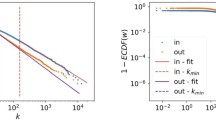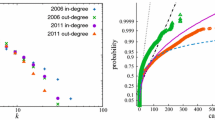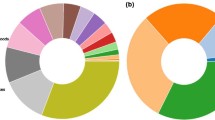Abstract
We present a simple model of firm rating evolution. We consider two sources of defaults: individual dynamics of economic development and Potts-like interactions between firms. We show that such a defined model leads to phase transition, which results in collective defaults. The existence of the collective phase depends on the mean interaction strength. For small interaction strength parameters, there are many independent bankruptcies of individual companies. For large parameters, there are giant collective defaults of firm clusters. In the case when the individual firm dynamics favors dumping of rating changes, there is an optimal strength of the firm’s interactions from the systemic risk point of view.
Similar content being viewed by others
References
Basel II: International Convergence of Capital Measurement and Capital Standards: a Revised Framework, The Basel Committee for Banking Supervision, Basel (2004), http://www.bis.org/publ/bcbs107.htm
R. Schäfer, M. Sjöllin, A. Sundin, M. Wolanski, T. Ghur, Phys. A 383, 533 (2007)
F. Allen, D. Gale, J. Polit. Econ. 108, 1 (2001)
L. Eisenberg, T.H. Noe, Manage. Sci. 47, 236 (2001)
S. Battiston, D. Deli Gatti, M. Gallegati, B. Greenwald, J.E. Stiglitz, J. Econ. Dyn. Cont. 31, 2061 (2007)
G. Weisbuch, S. Battiston, J. Econ. Behav. Organ. 64, 448 (2007)
U. Horst, J. Econ. Behav. Organ. 63, 25 (2007)
J.P.L. Hatchett, R. Kühn, J. Phys. A 39, 2231 (2006)
D. Egloff, M. Leippold, P. Vanini, J. Bank. Financ. 31, 2475 (2007)
A. Aleksiejuk, J.A. Hołyst, Phys. A 299, 198 (2001)
A. Aleksiejuk, J.A. Hołyst, G. Kossinets, Int. J. Mod. Phys. C 13, 333 (2002)
G. Iori, S. Jafarey, F.G. Padilla, J. Econ. Behav. Organ. 61, 525 (2006)
G. Iori, S. Jafarey, Phys. A 299, 205 (2001)
Y. Jafry, T. Schuermann, J. Bank. Financ. 28, 2603 (2004)
C. McNulty, R. Levin, RISK 13 (2000)
H. Nishimori, M.J. Stephen, Phys. Rev. B 27, 5644 (1983)
H. Nishimori, Statistical Physics of Spin Glasses and Information Processing (Oxford University Press, New York, 2001)
A. Van Landschoot, N. Jobst, in The handbook of structured finance, edited by A. de Servigny, N. Josef Jobst, 1st edn. (McGraw-Hill, 2007)
J. Lorenz, S. Battiston, Net. Heterogen. Med. 3, 185 (2008)
A. Eisdorfer, P.-H. Hsu, Technology Competition and Bankruptcy (2009), available at SSRN: http://ssrn.com/abstract=1300638
Author information
Authors and Affiliations
Corresponding author
Rights and permissions
About this article
Cite this article
Sieczka, P., Hołyst, J. Collective firm bankruptcies and phase transition in rating dynamics. Eur. Phys. J. B 71, 461–466 (2009). https://doi.org/10.1140/epjb/e2009-00322-1
Received:
Revised:
Published:
Issue Date:
DOI: https://doi.org/10.1140/epjb/e2009-00322-1




